1996 CHEVROLET TAHOE seats
[x] Cancel search: seatsPage 2 of 403
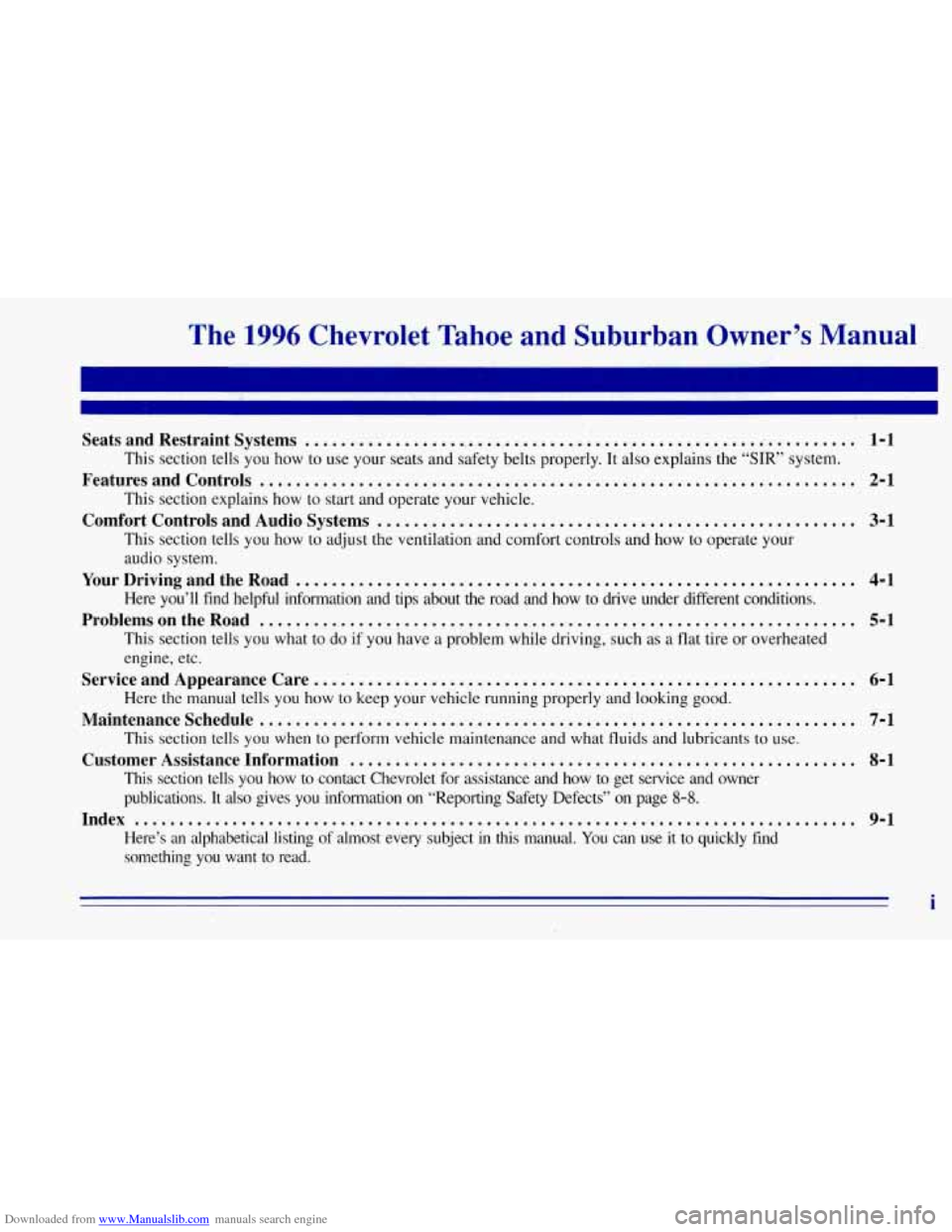
Downloaded from www.Manualslib.com manuals search engine The 1996 Chevrolet Tahoe and Suburban Owner’s Manual
Seats and Restraint Systems ............................................................... 1-1
This section tells you how to use your seats and safety belts\
properly. It also explains the “SIR’ system.
FeaturesandControls .................................................................. 2-1
This section explains how to start and operate your vehicle.
Comfort Controls and Audio Systems ..................................................... 3-1
This section tells you how to adjust the ventilation and comfort controls and how to operate \
your
audio system.
Here you’ll find helpful infomation and tips about the road \
and how to drive under different conditions.
This section tells you what to
do if you have a problem while driving, such as a flat tire or overheat\
ed
engine, etc.
Here
the manual tells you how to keep your vehicle running properly and\
looking good.
This section tells you when
to perform vehicle maintenance and what fluids and lubricants to u\
se.
This section tells you how
to contact Chevrolet for assistance ahd how to get service and ow\
ner
publications. It also gives you, information on “Reporting Sa\
fety Defects’’ on page
8-8.
Here’s an alphabetical listing of almost every subject in this manual. You can use it to quickly find
something
you want to read.
YourDrivingandtheRoad .............................................................. 4-1
ProblemsontheRoad ................................................................... 5-1
Service and Appearance Care ... .’. ....................................................... 6-1
Maintenanceschedule..................... ............................................. 7-1
Customer Assistance Information ........................................................ 8-1
Index ........................................................................\
........ 9-1
i
Page 8 of 403

Downloaded from www.Manualslib.com manuals search engine Section 1 Seats and Restraint Systems
Here you’ll find information about the seats in your Manual Front Seat
vehicle and how to use your safety belts properly. You
can also learn about some things you should nut do with
air bags and safety belts.
A CAUTION:
c
Seats and Seat Controls m
This section tells you about the seats -- how to adjust
them and fold them
up and down. It also tells you about
reclining front seatbacks and head restraints.
1
You can lose control of the vehicle if you try to
adjust
a manual driver’s seat while the vehicle is
moving. The sudden movement could startle and
confuse you, or make you push a pedal when you
don’t want to. Adjust the driver’s seat only when
the vehicle is not moving.
1-1
Page 14 of 403
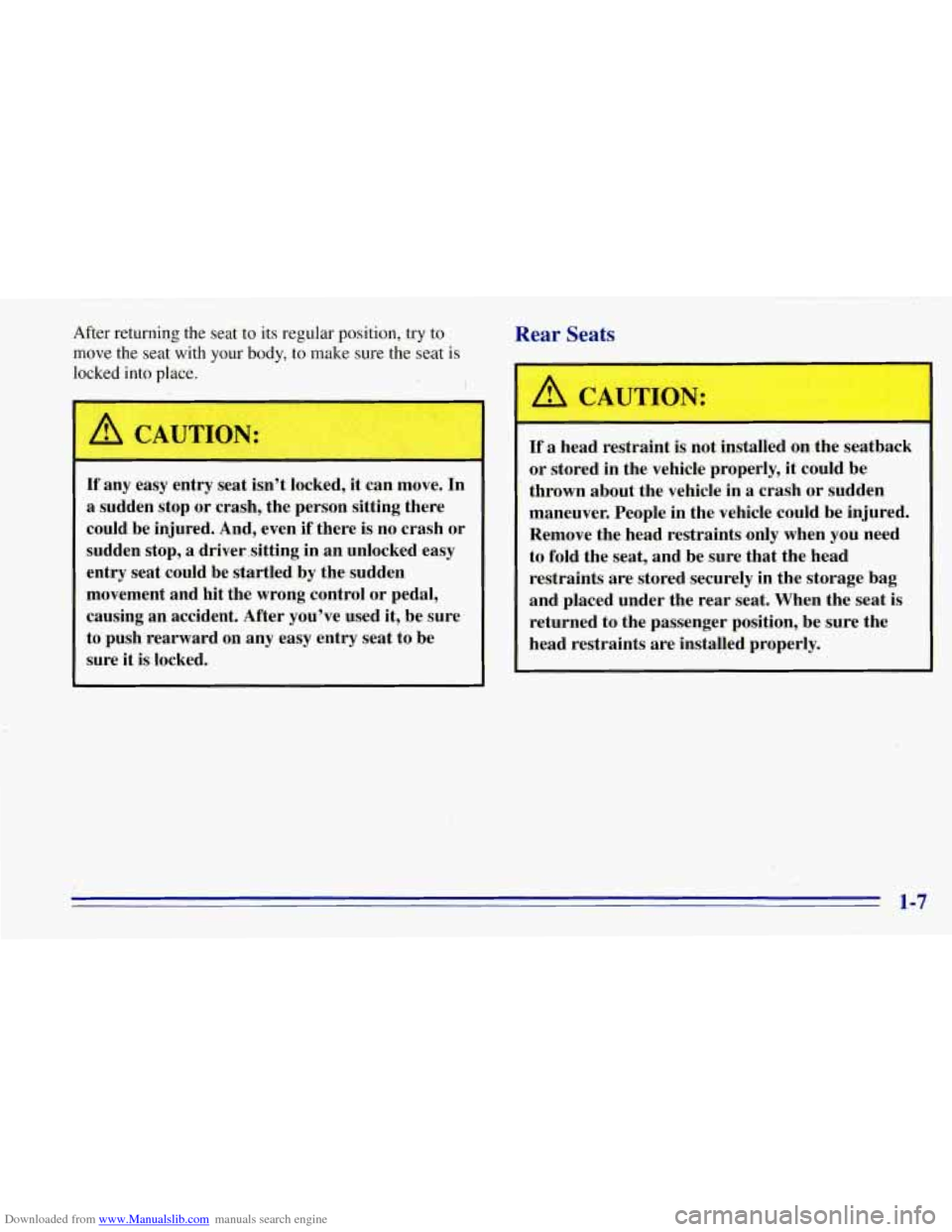
Downloaded from www.Manualslib.com manuals search engine After returning the seat to its regular position, try to
move the seat with your
body, to. make sure the seat is
locked into place. i
L
A
Rear Seats
b, CAUTION:
-
If any easy entry seat isn’t locked, it can move. In
a sudden stop or crash, the person sitting there
could be injured. And, even
if there is no crash or
sudden stop,
a driver,sitting in an unlocked easy
entry seat could be startled by the sudden
movement and hit the wrong control or pedal,
causing an accident. After you’ve used it, be sure
to push rearward on any easy entry seat to be
sure it is locked.
If a head restraint is not installed on.the seatback
or stored in the vehicle properly, it could be
thrown about the vehicle in a crash or sudden
maneuver. People in the vehicle could be injured.
Remove the head restraints only when you need
to fold the seat, and be sure that the head
restraints are stored securely in the storage bag
and placed under the rear seat. When the seat is
returned to the passenger position, be sure the
head restraints are installed properly.
1-7
Page 28 of 403
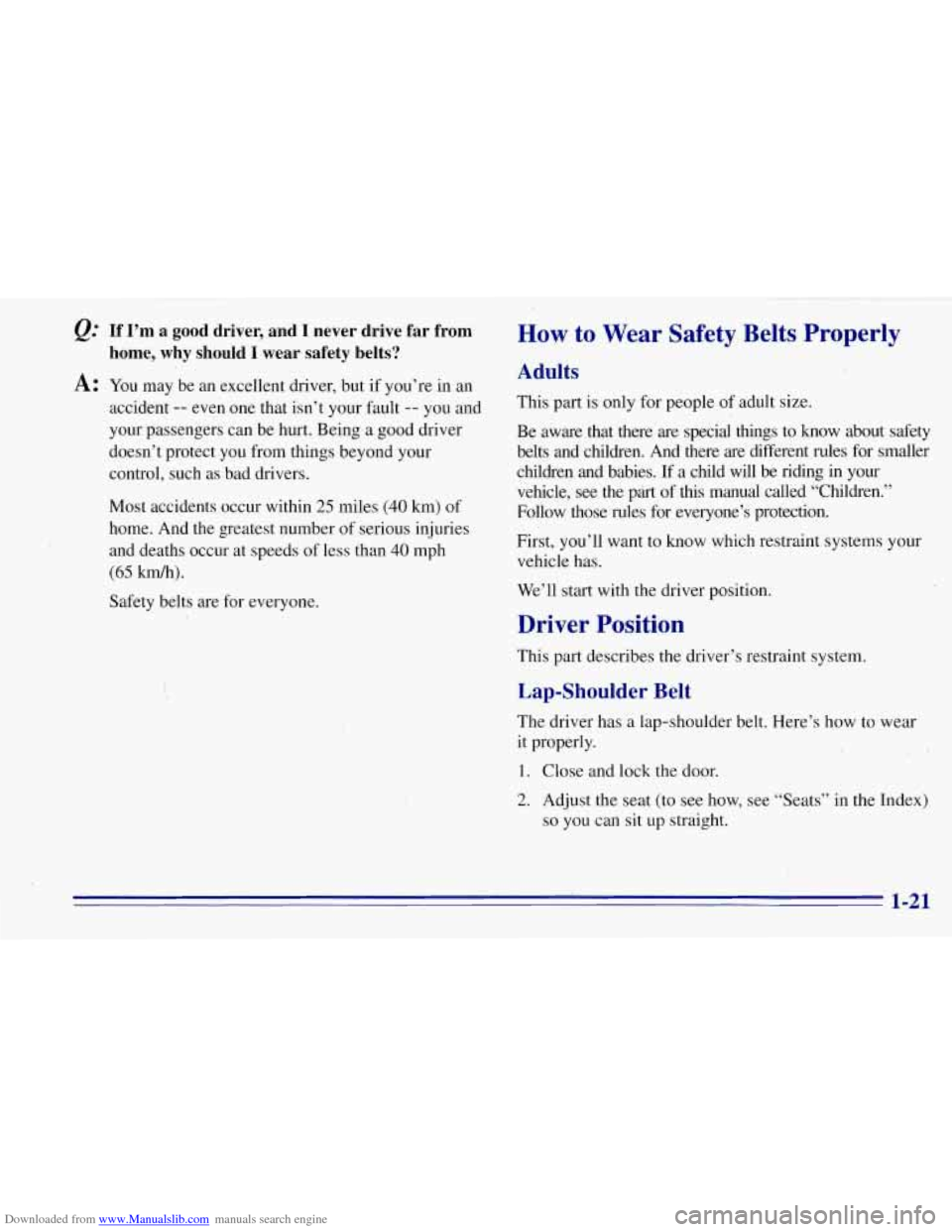
Downloaded from www.Manualslib.com manuals search engine @ If I’m a good driver, and I never drive far from
A: You may be an excellent driver, but if you’re in an
home, why should I wear safety belts?
accident -- even one that isn’t your fault -- you and
your passengers can be hurt. Being a good drivei-
doesn’t protect you from things beyond your
control, such as bad drivers.
Most accidents occur within
25 miles (40 krn) of
home. And the greatest number of serious injuries
and deaths occur at speeds of less than
40 mph
(65 km/h).
Safety belts are for everyone.
How to Wear Safety Belts- Properly
Adults
This part is only for people of adult size.
Be aware that there are special things to know about safety
belts and children. And there
are different rules for smaller
children
and babies. If a child will be riding .in your
vehicle, see the
part of this manual called “Children.”
Follow those rules for everyone’s protection.
First, you’ll want to know which restraint systems your
vehicle has.
We’ll start with the driver position.
Driver Position
This part describes the driver’s restraint system.
Lap-Shoulder Belt
The driver has a lap-shoulder belt. Here’s how to wear
it properly.
1. Close and lock the door.
2. Adjust the seat (to see how, see “Seats” in the Index)
so you can sit up straight.
..
1-21
Page 43 of 403
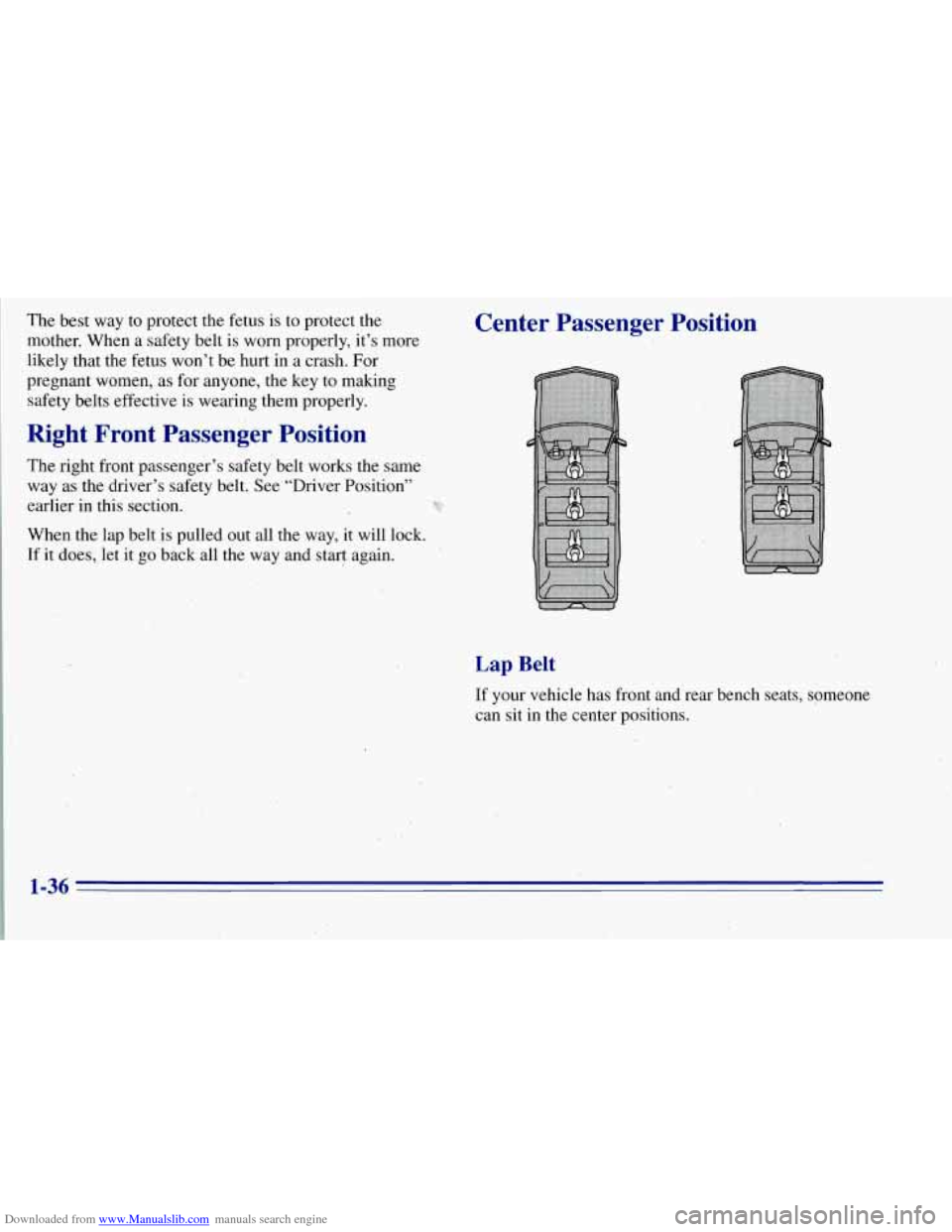
Downloaded from www.Manualslib.com manuals search engine The best way to protect the fetus is to protect the
mother. When a safety belt is
worn properly, it’s more
likely that the fetus won’t be hurt in a crash. For
pregnant women, as for anyone, the key to making
safety belts effective is .wearing them properly.
Right Front Passenger Position
The right front passenger’s s,afety belt works the same
way as the driver’s safety belt. See “Driver Position’’
earlier in this section.
#
When the lap belt is pulled out all the way, it will lock.
If it does,, let it go back all the way and start again.
Center. Passenger Position
Lap Belt
If your vehicle has front and rear bench seats, someone
can sit in the center positions.
1-36
Page 105 of 403
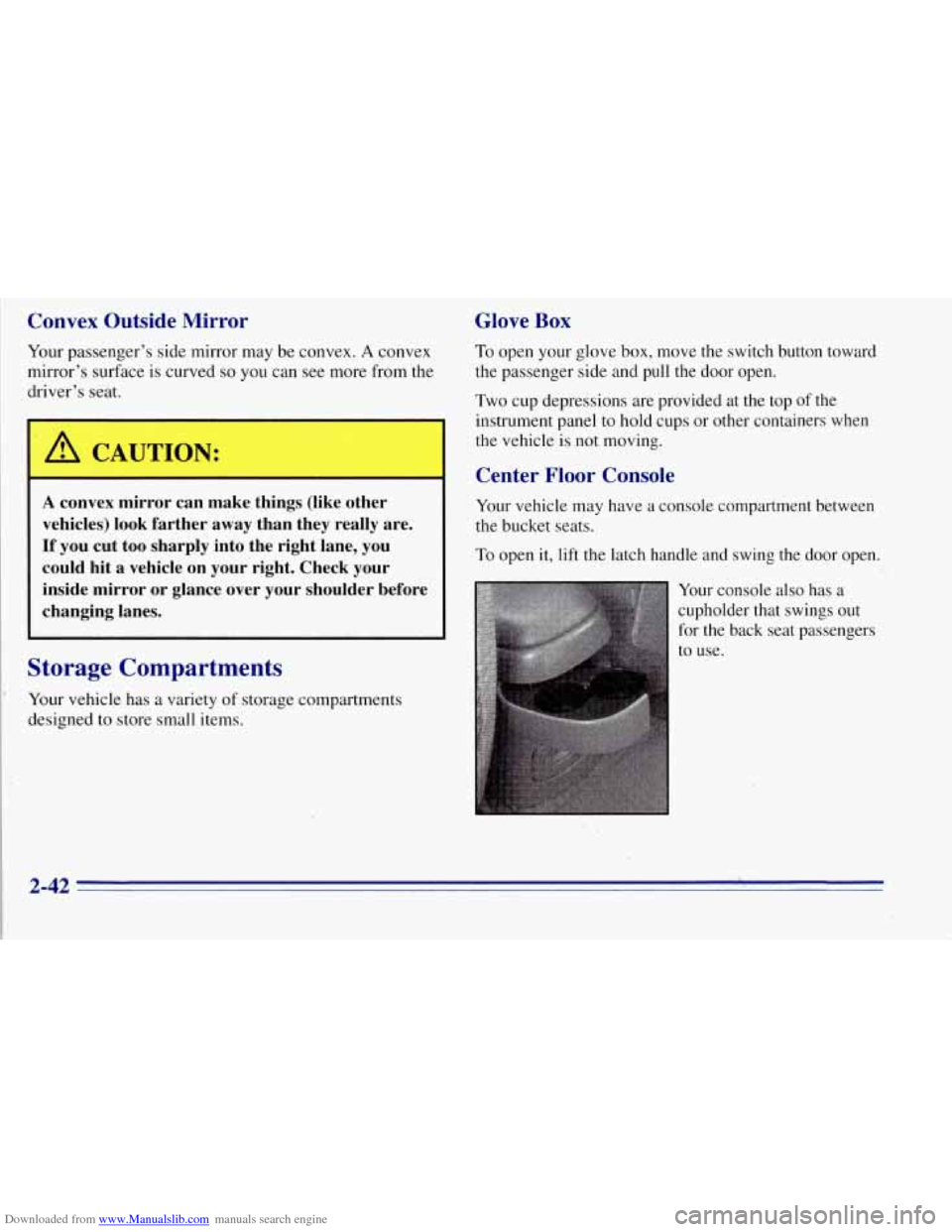
Downloaded from www.Manualslib.com manuals search engine Convex Outside Mirror
Your passenger’s side mirror may be convex. A convex
mirror’s surface is curved
so you can see more from the
driver’s seat.
I A CAUTION:
A convex mirror can make things (like other
vehicles) look farther away than they really are.
If you cut too sharply into the right lane, you
could hit a vehicle on your right. Check your
inside mirror
or glance over your shoulder before
changing lanes.
Storage Compartments
Your vehicle has a variety of storage compartments
designed to store small items.
Glove Box
To open your glove box, move the switch button toward
the passenger side and pull the door open.
Two cup depressions are provided at the top
of the
instrument panel to hold cups or other containers when
the vehicle is not moving.
Center Floor Console
Your vehicle may have a console compartment between
the bucket seats.
To open it, lift the latch handle and swing the door open.
Your console also has a
cupholder that swings out
for the back seat passengers
to use.
2-42
Page 134 of 403
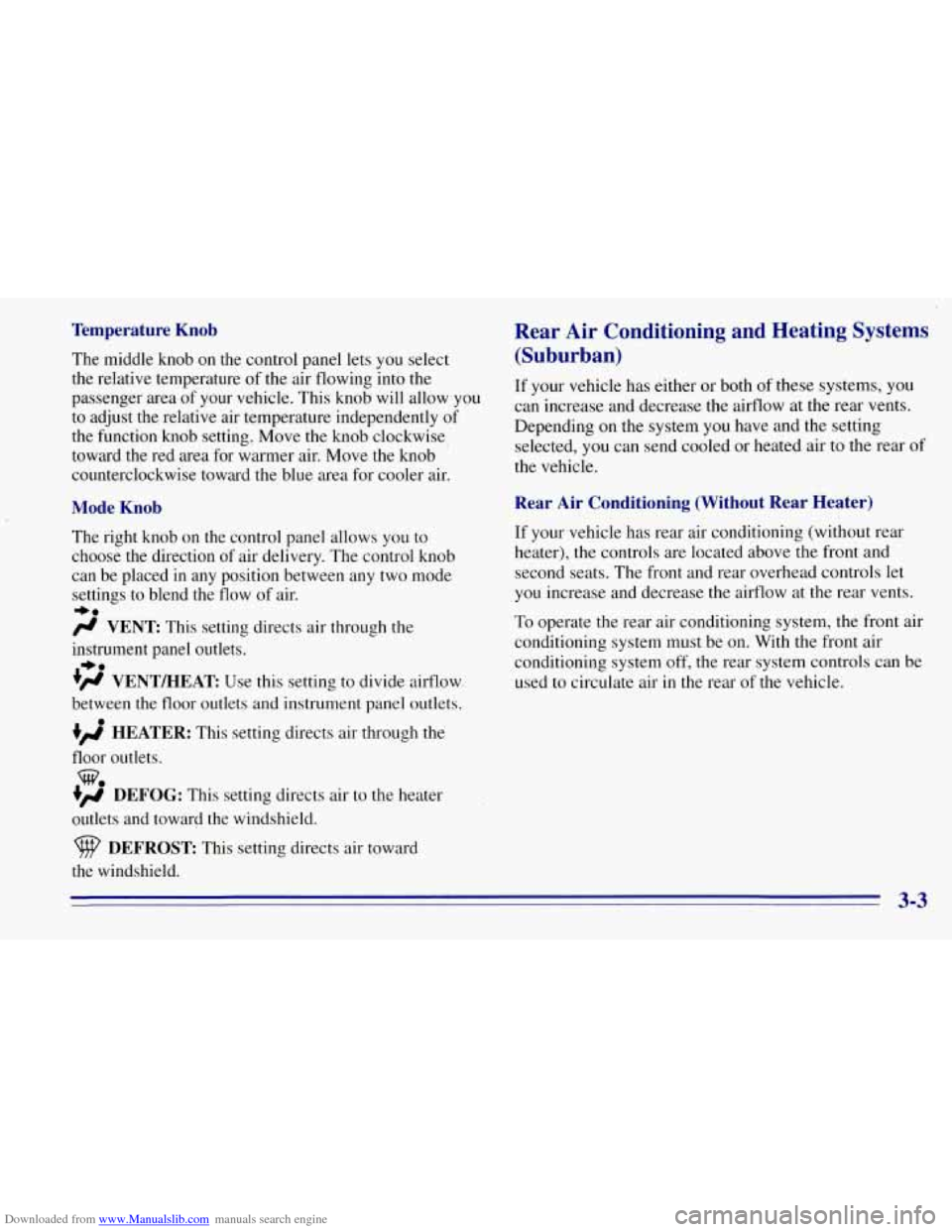
Downloaded from www.Manualslib.com manuals search engine Temperature Knob
The middle knob on the control pane-1 lets you select
the relative temperature of the air flowing into the
passenger area of your vehicle. This knob will allow you
to adj.ust the relative air temperature independently of
the function knob setting, Move the knob clockwise
toward the red area for warmer air. Move the knob
counterclockwise toward the blue area for cooler air.
Mode Knob
The right knob on the control panel allows you to
choose the direction of air delivery. The control knob
can be placed in any position between any two mode
settings to blend the flow of air.
+e
# VENT This setting directs air through the
instrument panel outlets.
+’ VENTMEAT Use this setting to divide airflow.
between the floor outlets and instrument panel outlets.
+e
HEATER: This setting directs air through the
floor outlets.
+# DEFOG: This setting directs air to the heater
outlets and toward the windshield.
9 DEFROST This setting directs air toward
the windshield.
w.
Rear Air Conditioning and Heating Systems
(Suburban)
’
If your vehicle has either or both of these systems, you
can increase and decrease the airflow at the rear vents.
Depending on the system
you have and the setting
selected,
you can send cooled or heated air to the rear of
the vehicle.
Rear Air Conditioning (Without Rear Heater)
If your vehicle has rear air conditioning (without rear
heater), the controls are located above the front and
second seats. The front and rear overhead controls let
you increase and decrease the airflow at the rear vents.
To operate the rear air conditioning system, the front air
conditioning system must be on. With the front air
conditioning system off, the rear system controls can be
used to circulate air in the rear of the vehicle.
3-3
Page 139 of 403
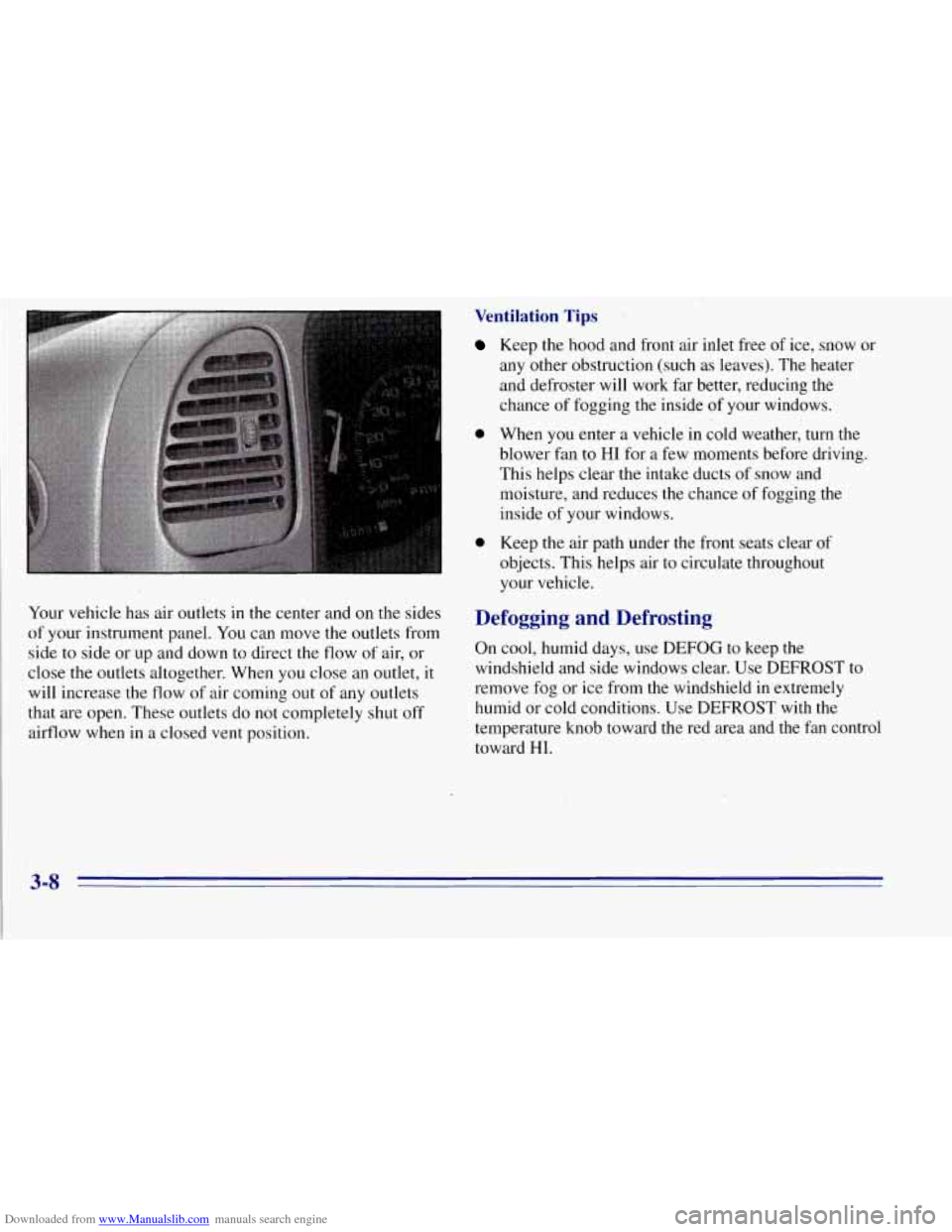
Downloaded from www.Manualslib.com manuals search engine Your vehicle has air outlets in the center and on the sides
of your instrument panel. You can move the outlets from
side to side or up and down to direct the flow
of air, or
close the outlets altogether. When you close an outlet, it
will increase the flow
of air coming out of any outlets
that
are open. These outlets do not completely shut off
airflow when in a closed vent position.
0
0
Ventilation Tips
Keep the hood and front air inlet free of ice, snow or
any other obstruction (such as leaves). The heater
and defroster will work far better, reducing the
chance
of fogging the inside of your windows.
When you enter a vehicle in cold weather, turn the
blower fan to HI for a few moments before driving.
This helps clear the intake ducts of snow and
moisture, and reduces the chance
of fogging the
inside of your windows.
Keep the air path under the front seats clear of
objects. This helps ,air to circulate throughout
your vehicle.
efogging and Defrosting
D
On cool, humid days, use DEFOG to keep the
windshield and side windows clear. Use DEFROST to
remove fog or ice from the windshield in extremely
humid or cold conditions. Use DEFROST with the
temperature knob toward the red area and the fan control
toward HI.
3-8